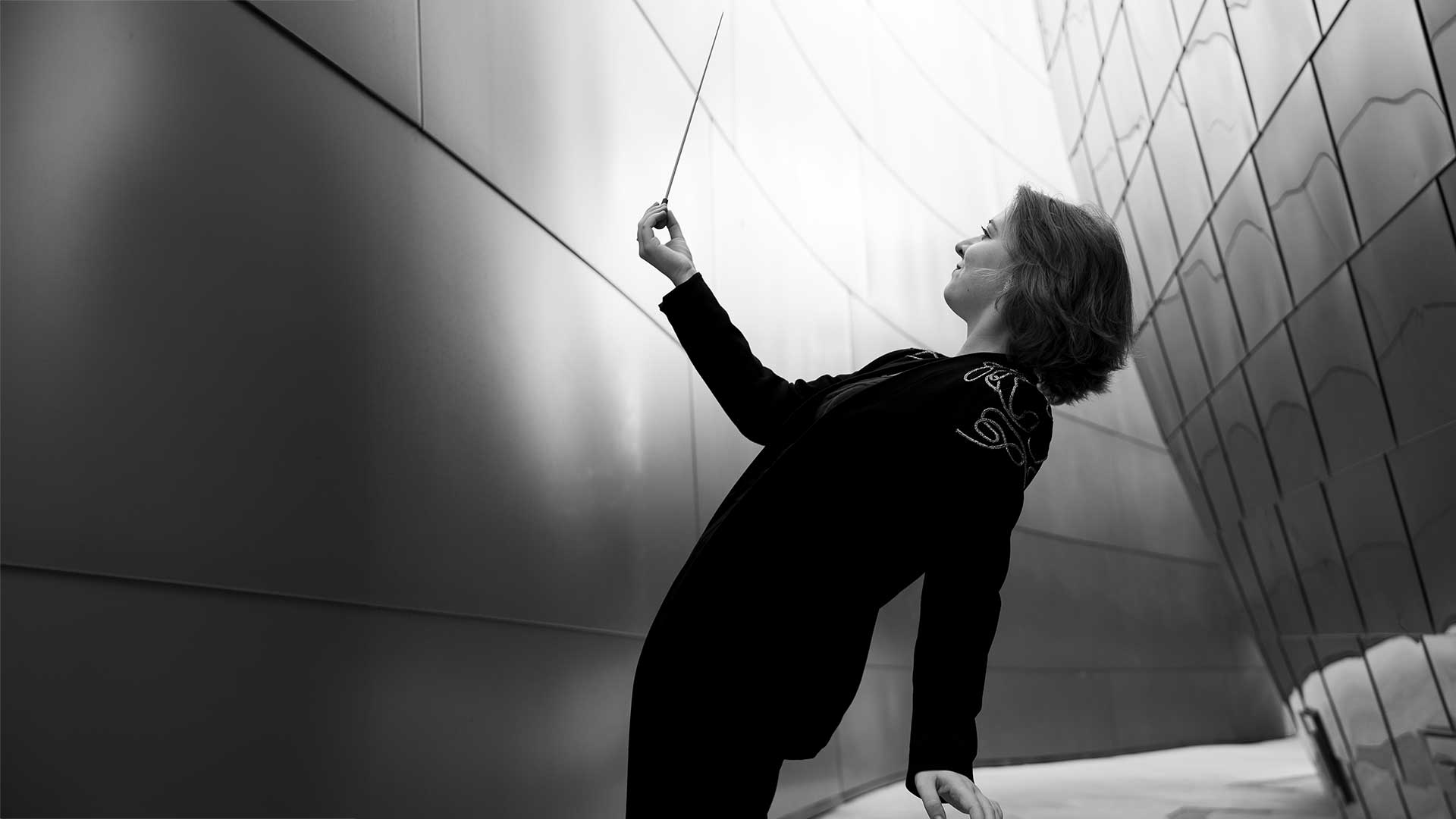Aleksandra Melaniuk conducts a programme in which both the orchestra and the conductor get to show off their abilities.
In 1950, Polish composer Witold Lutosławski received a commission from the Warsaw Philharmonic: “Write something brilliant with which the orchestra can celebrate its rebirth.” His Concerto for Orchestra was composed as a sign of recovery from the devastation of the German occupation.
Some seventy years earlier, Antonín Dvořák also received an interesting commission. A business-minded publisher asked him to write music that would be a hit among the bourgeois families who practiced music at home: catchy pieces based on material from Dvořák's childhood in the Bohemian countryside. The resulting Slavonic Dances became an enormous success and made Dvořák famous all over the world.
Duration appr. one hour, no interval.
Witold Lutosławski: Concerto for Orchestra
Witold Lutosławski (1913–1994) was one of the greatest composers of the 20th century. As a young man he studied the violin, piano and mathematics, and composition with Witold Maliszewski. Later, he also toured the world conducting his own compositions. He would in time receive many major awards, such as the Danish Sonning Prize and the US Gravemeyer, and in 1973 the Sibelius Prize of the Jenny and Antti Wihuri Foundation in Finland.
The Concerto for Orchestra marked the culmination of Lutosławski’s early period, before he embarked on his experiments with aleatory.
The Concerto for Orchestra marked the culmination of Lutosławski’s early period, before he embarked on his experiments with aleatory (sounds chosen by the performer or left to chance). It was commissioned by Witold Rowicki, Artistic Director of the Warsaw Philharmonic Orchestra, and dedicated to him. Lutosławski struggled with it for four years. The premiere in 1954 was quite a sensation, for though it draws on folk music of the Mazovia region of Poland, the melodies and rhythms undergo such radical transformations that they are far removed from National Romanticism or socialist realism. A colourful work rich in fantasy, the Concerto for Orchestra is in three movements.
Antonín Dvořák: Slavonic Dances, Op. 46
Antonín Dvořák (1841–1904) originally wrote his eight Slavonic Dances, Op. 46 for two pianos four hands in 1878. The idea came from the publisher Fritz Simrock, who had noted the popularity of the Hungarian Dances by Brahms and decided to strike while the iron was hot. He was not disappointed; Europe was caught up in a wave of nationalism and with it nationalist music, and there was a great demand for music for amateur pianists to play. In order to boost sales even further, Simrock quickly commissioned versions of Dvořák’s Dances for large orchestra. These were an immediate hit and so Simrock asked Dvořák to write a further eight. Despite their name, they are Slavonic only in mood and temperament, and listeners will search in vain for genuine folk melodies. They do, however, feature rhythms associated with specific regions: seven of them Dvořák’s native Bohemia and one, “Dumka” (no. 2), probably Serbia.
Aleksandra Melaniuk
Aleksandra Melaniuk is a Salonen Conducting Fellow in the Negaunee Conducting Program at Colburn and the San Francisco Symphony. She was the youngest semi-finalist in the 17th Donatella Flick Conducting Competition, where she conducted the London Symphony Orchestra. Her recent highlights include a debut with the San Francisco Symphony’s SoundBox series and serving as Associate Conductor for Verdi’s La Traviata at Opera Holland Park.
Aleksandra Melaniuk has worked as a cover conductor with Orchestre de Paris, Los Angeles Philharmonic, San Francisco Symphony (with Esa-Pekka Salonen), Royal Concertgebouw Orchestra, and Orquesta Nacional de España (with Simone Young). Aleksandra was named one of the winners of the 2023 Das Kritische Orchester competition and was a semi-finalist at the International Conducting Competition in Rotterdam.
Melaniuk is passionate about opera and has assisted in productions such as Bizet’s Carmen and Mozart’s La Clemenza di Tito at the Baltic Opera. She joined The Ziering-Conlon Initiative for Recovered Voices in 2025, reviving music by suppressed 20th-century European composers.
Violin 1
Pekka Kauppinen
Jan Söderblom
Taija Angervo
Eija Hartikainen
Katariina Jämsä
Elina Lehto
Ilkka Lehtonen
Jani Lehtonen
Kari Olamaa
Kalinka Pirinen
Satu Savioja
Elina Viitasaari
Anna Tanskanen
Sirkku Helin
Sayaka Kinoshiro
Öykü Melis Sahin
Violin 2
Ángeles Salas Salas
Teija Kivinen
Kamran Omarli
Heini Eklund
Serguei Gonzalez Pavlova
Dhyani Gylling
Matilda Haavisto
Linda Hedlund
Liam Mansfield
Siiri Rasta
Krista Rosenberg
Virpi Taskila
Alexis Mauritz
Viola
Torsten Tiebout
Petteri Poijärvi
Aulikki Haahti-Turunen
Kaarina Ikonen
Tiila Kangas
Ulla Knuuttila
Carmen Moggach
Liisa Orava
Markus Sallinen
Hajnalka Standi-Pulakka
Charlotta Westerback
Olli Kilpiö
Cello
Lauri Kankkunen
Beata Antikainen
Kalle-Pekka Koponen
Veli-Matti Iljin
Ilmo Saaristo
Saara Särkimäki
Hans Schröck
Sami Mäkelä
Maria Morfin Venäläinen
Bass
Pauli Pappinen
Matis Eissaks
Jon Mendiguchia
Paul Aksman
Eero Ignatius
Tuomo Matero
Henri Dunderfelt
Jukka Räikkönen | Flute
Niamh McKenna
Päivi Korhonen
Jenny Villanen
Oboe
Hannu Perttilä
Paula Malmivaara
Nils Rõõmussaar
Clarinet
Harri Mäki
Anna-Maija Korsimaa
Heikki Nikula
Bassoon
Markus Tuukkanen
Erkki Suomalainen
Noora Van Dok
Horn
Ruben Buils Garcia
Mika Paajanen
Joonas Seppelin
Péter Jánosi
Trumpet
Pasi Pirinen
Thomas Bugnot
Obin Meurin
Mika Tuomisalo
Jonas Silinskas
Trombone
Victor Álvarez Alegria
Anu Fagerström
Jussi Vuorinen
Tuba
Ilkka Marttila
Timpani
Tomi Wikström
Percussion
Tuomas Siddall
Mikael Sandström
Teo de la Cruz
Alex Martin Agustin
Jani Niinimäki
Harp
Katilyne Roels
Minnaleena Jankko
Piano
Mirka Viitala
Celesta
Anna Kuvaja
|

